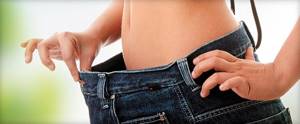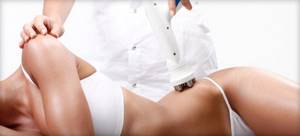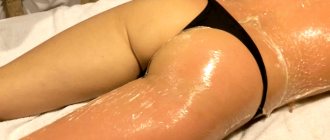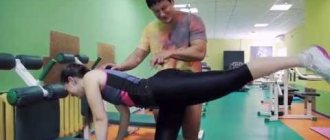- Description of the procedure
- Indications
- Step-by-step instructions for the procedure
- How many procedures will be required and how often can it be done?
- Impact zones
- Effect before and after the procedure
- Pros and cons of ultrasonic cavitation
- Disadvantages of ultrasonic cavitation
- Contraindications
- Preparation for the procedure
- Side effects
- Ultrasonic cavitation and liposuction
- Vacuum Ultrasonic Cavitation
- Ultrasonic cavitation and RF lifting
- Carrying out the procedure at home
Ultrasonic cavitation is called the new non-surgical liposuction. With its help, you can lose weight in problem areas and tighten your body without injections or exhausting physical activity. Noticeable transformations are visible after the first procedure, and the results of completing the course are similar to a month of classes in the fitness room.
However, to maintain the result, it is necessary to rebuild your diet. If you overeat, the split fat will form again.
Description of the procedure
Ultrasonic cavitation is a cosmetic, non-injection procedure for removing unwanted fat in problem areas.
How does ultrasonic cavitation work:
- The device emits low-frequency ultrasound;
- Inside the fat cells (adipocytes), in response to ultrasound, a small bubble is formed, which gradually increases;
- The adipocyte swells, the cell membrane (wall) cannot withstand the tension and ruptures;
- The adipocyte is destroyed, and all the structures that were inside the cell are broken down into breakdown products (triglycerides), enter the lymphatic and blood vessels, then go to the liver and are broken down into glucose - the energy substrate for any cells in the body.
Low-frequency ultrasound waves have a destructive effect only on adipocytes; they do not have such a pronounced effect on other cells (skin, muscles and blood vessels) (without negative consequences) due to the strength and elasticity of these structures.
Cavitation method - what is it?
The bottom line is this: low-frequency ultrasonic waves have a direct effect on fat layers and help get rid of cellulite. Under the influence of acoustic waves, cavitation bubbles form in fat cells. When they burst, they increase the size of the cells, “pushing” fat towards the membrane, and then “pushing” it out. Cells are destroyed. In this case, 90 percent of the fat enters the lymph (the fluid that washes cells and tissues), and the rest enters the blood, where it is processed into glucose.
As a result of the loss of excess fat , unnecessary volumes are removed, the skin tightens and becomes smooth . The procedure affects only fat cells; all others remain intact, since their shell is stronger. The intensity of the cavitation effect is under the control of a medical specialist. The result of applying the method “doesn’t keep you waiting” and is visible after the first session. At the end of the course, you can reduce your waist by 3 to 5 centimeters.
Step-by-step instructions for the procedure
Stages of ultrasonic cavitation:
- Consultation with a cosmetologist. Anamnesis collection, examination, exclusion of contraindications for the procedure. Selecting the treated area.
- Setting up the device. The patient is positioned on the couch in a supine or reclining position. A special gel is applied to the problem area (similar to what is used during ultrasound so that the skin does not rub and the device’s sensor fits tightly to the body).
- Carrying out ultrasonic cavitation. Depending on the area, the procedure lasts from 20 to 40 minutes.
- Completion of the session: the patient wipes the remaining gel from the skin.
To enhance the fat burning effect, it is recommended to undergo additional cosmetic procedures: pressotherapy, lipolytic injection cocktails, lymphatic drainage or massage.
How to enhance the effectiveness of the procedure
To achieve a stronger and more lasting effect from ultrasonic cavitation of the body, it is recommended:
- In addition to the ultrasonic cavitation procedure, carry out lymphatic drainage massage or pressotherapy.
- Follow the diet and drinking regime.
- Incorporate sports and active recreation into your usual lifestyle.
- Follow all recommendations when preparing for a cavitation session and after it.
- Use moisturizer.
- Carry out the ultrasonic cavitation method in trusted clinics and salons.
Pros and cons of ultrasonic cavitation
Benefits of the procedure:
- There are no age restrictions;
- Uniform figure correction;
- No anesthesia (even local) or painkillers are needed;
- Used over a large area of the body;
- No rehabilitation required;
- The integrity of the skin is not compromised (no punctures or cuts);
- There are no scars, marked swelling or bruises after the session;
- Skin sensitivity is completely preserved;
- Lifting effect (skin tightening);
- The result is noticeable after several procedures;
- Cumulative effect;
- Pronounced figure correction after completing the course;
- There are no strict restrictions even on the day of the procedure.
Preparation
For better results and reduced side effects, you need to prepare for each cavitation session:
- A few days before the ultrasound cavitation procedure, exclude fried, too high-calorie, fatty, and spicy foods from your diet.
- Drink 2–2.5 liters of pure non-carbonated water per day.
- Be sure to avoid any alcohol-containing drinks 5-7 days before the procedure.
- On the day of cavitation, it is recommended to peel the skin. But it is better to first consult with the specialist who will perform the procedure.
- Immediately before the procedure, you should drink 1 liter of pure water without gases.
It is recommended to carry out the procedure only in a good clinic or salon with a highly qualified specialist who has certificates and positive reviews.
Examination before the procedure
Due to the fact that there are many contraindications to cavitation in women, before starting the fight against excess fat, the patient is recommended to undergo a medical examination, which will make sure that there are no diseases from the list of contraindications:
- general and biochemical blood test;
- cardiogram;
- echogram;
- fluorography;
- bioimpedansometry.
This responsible approach will help reduce the possible risk of harm to health from cavitation.
Contraindications
- Pregnancy and lactation;
- Oncological diseases;
- Bleeding disorders;
- Metal structures in the treated area (prostheses);
- Autoimmune diseases or immunosuppression (decreased immunity);
- Osteoporosis;
- Liver diseases;
- Kidney failure;
- Diabetes;
- Damage to the cardiovascular system;
- Presence of a pacemaker or other electronic devices to maintain life support;
- Hernias;
- Violation of the integrity of the skin in the treated area;
- Individual intolerance to ultrasound;
- Exacerbation of chronic diseases.
Contraindications to cavitation liposuction
The ultrasonic cavitation method has been studied in detail, which has made it possible to prove its effectiveness. The procedure compares favorably with other methods of body correction: the integrity of the tissue is not compromised, no bruises form after the session, no change in skin color occurs, it becomes more elastic, the sensitivity of the treated area is maintained and there is no rehabilitation period. However, a quick and noticeable result is not available to everyone: the procedure leads to a sharp elimination of some fat deposits, which is stressful for the body, and this causes a very long list of restrictions.
It is prohibited to resort to cavitation liposuction if you have the following problems and conditions:
- obesity more than first degree;
- disorders of the cardiovascular system;
- problems with normal blood clotting;
- autoimmune diseases;
- diseases of the ovaries and uterus;
- hepatitis in any form;
- kidney or lung problems;
- the presence of inflammatory rashes on the skin, especially with the presence of purulent discharge;
- birth of a child less than six months ago;
- pregnancy;
- diabetes mellitus (insulin-dependent form);
- predisposition to the formation of keloid scars;
- infectious diseases during exacerbation;
- any benign or malignant formations in the body.
Separately, it is worth noting that experts have some differences of opinion regarding the effect of ultrasound on the internal genital organs - some authors believe that the waves can have a negative impact on the functioning of the organs. Since the most common area of influence is the buttocks, thighs and abdomen, in close proximity to which the human genitourinary system is located, any disturbances in its functioning will be direct and strict contraindications to attending the procedure.

Be sure to pay attention to the fact that bearing a child and the lactation period are a strict contraindication to the liposuction procedure. This is explained by the fact that ultrasound cavitation technology can provoke a miscarriage, the formation of irreversible disorders in the development of the child, or the release of fat cell breakdown products into the milk. It is better to refuse the procedure or reschedule it if there is even the slightest chance of pregnancy or even if breastfeeding is rare and irregular. Another condition is the mandatory absence of any metal inclusions in the body (this could be bone pins or pacemakers).
The ultrasound cavitation procedure also has a small list of relative contraindications, the importance of which is determined in each individual case. We are talking about scars and tattoos at the site of the device’s impact, as well as taking non-steroidal anti-inflammatory drugs or anticoagulants in the last days before the procedure.
Harm to health and consequences after the procedure
The first thing worth noting is the lack of an immediate effect, which many people mistakenly expect. To get rid of fat deposits in all problem areas, many procedures are needed, and in the most difficult areas several approaches may be needed.

The mechanism of action of the device itself can provoke a number of negative consequences:
- the released breakdown products of fat cells affect blood sugar levels, which makes diabetes mellitus a direct contraindication to cavitation, however, this consequence can also provoke increased cholesterol formation, the development of osteoporosis and a decrease in the elasticity of other tissues;
- the developers claim that muscles, vessel walls, bones and joints have greater elasticity compared to fatty deposits, and that is why they do not disintegrate when exposed to ultrasound waves. However, the phenomenon of cellular memory cannot be denied, and it is unknown what will happen to these tissues when their elasticity decreases with age;
- a separate burden falls on the kidneys and liver, since they need to process a larger number of cells for excretion;
- One of the most possible and periodically occurring consequences of the procedure is the formation of wen, most often in the area under the knee. The only way to get rid of this formation is through surgery.
Side effects
Ultrasonic cavitation is a safe method of non-surgical liposuction. However, in some cases side effects are possible:
- Skin burn. This is a common problem for people with sensitive skin, which is why it is so important to answer your doctor’s questions honestly during the consultation before the procedure.
- Dehydration of the skin. After the destruction of adipocytes, their remains and metabolic products are urgently sent to the lymph and blood to “clean up” the site of the lesion. As a result, the amount of intercellular fluid is locally reduced, and the skin may be drier than usual for several days. The problem goes away on its own 24-48 hours after the procedure.
- Inflammatory reaction. Possible in the presence of immune diseases.
Ultrasonic cavitation and liposuction
Traditional liposuction is a surgical method for removing excess fat tissue. It is traumatic, dangerous and requires preparation before surgery and recovery after it.
Laser liposuction is a minimally invasive method for removing excess fat tissue. First, adipocytes are destroyed by laser radiation, after which the fat is pumped out through a thin cannula. The disadvantages of this method are the same as the traditional one: it is a traumatic, dangerous method that requires pain relief, preparation for surgery and rehabilitation.
With ultrasonic cavitation, punctures and cuts are not required. The skin remains intact. After the action of ultrasound, ruptured adipocytes are broken down into fatty acids and sent by lymph and blood to the liver, where they are used as energy. The technique is painless and does not require hospitalization, preparation or recovery after the procedure. And in terms of effectiveness, ultrasonic cavitation is not inferior to traditional and laser liposuction, if we are talking about small excess weight (up to 10-15 kg).
If the patient is severely obese (15 or more extra kg), then more radical methods of removing adipose tissue are required.
Vacuum Ultrasonic Cavitation
The procedure is carried out using one device, which combines the effects of ultrasound and vacuum. Thanks to the first, lipolysis (breakdown of fat) occurs, and with the help of the second, fatty acids are removed from the body faster, improving the overall effect of liposuction.
After vacuum ultrasonic cavitation, lymphatic drainage is not required, since it is performed during the procedure itself. As a result of vacuum massage, tissue metabolism is stimulated and the skin is tightened.
The effect of this combined procedure is noticeable after the first session (minus 2 cm in the waist). After a few days the results will improve.
During classical ultrasonic cavitation, up to 15 cm3 of fat can be removed at a time, and vacuum ultrasonic cavitation removes about 20 cm3 of fat mass at a time. In addition, the combined procedure is carried out faster - only 30 minutes, while classic ultrasound cavitation followed by lymphatic drainage will take 1-1.5 hours with the same effectiveness.
Well
For maximum effectiveness, you need to complete a full course of ultrasonic cavitation. How many cavitation procedures do you need to do to achieve long-term results? Cosmetologists claim that the amount depends on the degree of fat deposits, but on average from 5 to 10 sessions.
The minimum period between procedures cannot be less than 5 days, ideally it is 10 days.
The duration of one session is 45–60 minutes.
How often can body cavitation be performed? To maintain the effect, it is enough to carry out a course of 1-3 ultrasonic cavitation procedures every 6 months.
Cost of one ultrasonic cavitation procedure:
- minimum price 2,000 rubles;
- maximum – 6,000 rubles;
- average – 3,000–4,000 rubles.
The price depends on the city, the level of the clinic, the qualifications of the technician, the cost of the device and other factors, so it is impossible to say in advance exactly how much you will have to pay.
On average, a full course of 10 sessions will cost from 20,000 to 60,000 rubles. Please note that the price may depend on the selected problem area.
Ultrasonic cavitation and RF lifting
RF lifting is a non-invasive rejuvenation method that operates using high-frequency current. It penetrates into the deep layers of the dermis, warms them, improves blood microcirculation and oxygen saturation of tissues, accelerates metabolic processes in cells and activates the synthesis of collagen and elastin - the main components responsible for skin elasticity. The skin is smoothed and tightened, its color improves.
Ultrasonic cavitation is aimed at burning fat deposits. The greatest effect of the procedure is achieved by combining ultrasonic cavitation with RF lifting. Subcutaneous fat is broken down, and thanks to heating, the removal of the resulting fatty acids from the site of destruction of adipocytes is accelerated. Improved microcirculation prevents the development of edema. In addition, after the formation of voids under the skin, it tightens faster without sagging. Both procedures complement and enhance each other. Therefore, it is recommended to combine them.










